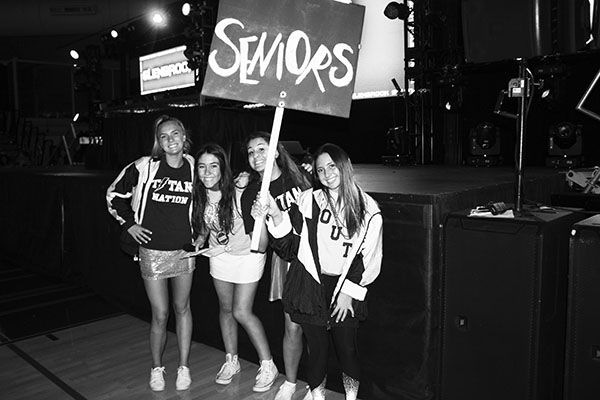South’s prevalent female leadership fights stereotypes, inspires

WINNIN’ WOMEN: Smiling at the 2018 Pep Rally, seniors Cat Berg, Abby Grant, Gracie Hambourger and Bebe Haramaras show their spirit. The four senior girls make up South’s first all-female executive board. Photo courtesy of Abby Grant
March 16, 2018
“The future is female.” A bold phrase, I know. But in this day and age we live in, one in which statements transcend into action and change, I could not stand behind this assertion more strongly. To me, a “female future” is one where women continue to have a greater stake in society.
Whether it be in the private sector, politics, medicine or STEM fields, women across the world are breaking glass ceilings every day.
According to a Pew’s “Women in Leadership Positions” Research Study, in 1990, there were only 25 women serving in congress. Now, there are over 100 congresswomen on Capitol Hill. The same study found that women in the labor force are taking similar strides; in 1968 only 30 percent of managerial positions were held by women; in 2013, 52 percent of managers were women.
It’s hard to put such a major societal shift into perspective. Looking around GBS, the influential role my female peers play could not be more evident. Our Student Council Executive Board is comprised of four girls for the first time ever, and countless clubs and organizations are being led by girls as well: Key Club, Debate, Model UN, Amnesty International, Yearbook and Oracle (just to name a few).
Alex Ladan, co-admin of Key Club, says one of the best skills she has gained from leading is being able to both advocate and execute her ideas. She says that through Key Club, she has developed a “go getter” attitude which has given her the ambition to seek out new projects.
This same attitude, however, is something that women in leadership positions often struggle to grasp. According to the Wall Street Journal, one of the toughest skills women leaders must learn is how to navigate a “double bind,” that is balancing their assertiveness and femininity. The article states that “if [a woman] asserts themselves forcefully, people may perceive them as not acting feminine enough, triggering a backlash. But if they act in a stereotypically feminine way, they aren’t seen as strong leaders.”
This balance is something I have grappled with all year, particularly in relation to working with some of my male peers. The eye-rolls while I’m talking or the not so-hidden chuckles: I see it all and it hurts. When is the right time to say something or speak up? Is there ever a right time, or is this the way things are supposed to be?
According to Ladan, by having more confidence when presenting their ideas, women are less likely to receive backlash from their male peers. Ladan says throughout her junior year, she experienced aggressiveness from a male board member when she would present ideas. Although dealing with backlash from male peers can be difficult, Ladan says it is important girls take ownership for their ideas and defend them even if a male counterpart shuts them down.
Unfortunately, these types of experiences go on past GBS. According to Pew, eight in ten women say that they experience gender related bias in the workforce, which they say has inhibited them from attaining a promotion or greater benefits. To me, this number is unacceptable and needs to change.
You might ask, ‘How do we get that change, and reach that “female future”?’ The answer is simple: provide leadership opportunities to girls starting in their youth. Supplying girls with an outlet to lead at a young age gives them the confidence to seek further command in the future.
Illustrating this concept, KPMG found that 74 percent of women who were encouraged to lead as children aspired to senior leadership roles later on, while only 48 percent of those who didn’t receive childhood encouragement felt similarly.
Even at our age, leadership opportunities empower girls and young women within our community and instill the confidence and courage that our future leaders need.
According to Gracie Hambourger, student body treasurer, despite the challenges she has faced with balancing her assertiveness, she feels the all-female executive board reflects a sense of confidence in female leadership from the student body.
“I think a huge part of [dealing with backlash from my male peers] is that there are four females on executive board that … are the main representatives of the student body,” Hambourger said. “That’s a nice thing to kind of be able to point to and say ‘we were the four people that you chose [to lead the school].’”
I can wholeheartedly say that without having the role models I did and seeing females lead by example at GBS, I would not have the confidence to seek leadership opportunities. Looking up to other successful female leaders only inspired me to want to follow in their footsteps. Now, as a leader myself in both the Oracle and in Model UN, I hope I have continued the legacy my female forerunners left for me.
So ladies, continue to lead and seek every opportunity both here at GBS and beyond. The skills and experiences we attain from leading are intangible and will help to inspire an entirely new generation of female leaders. If the future really is female, what are we waiting for?


